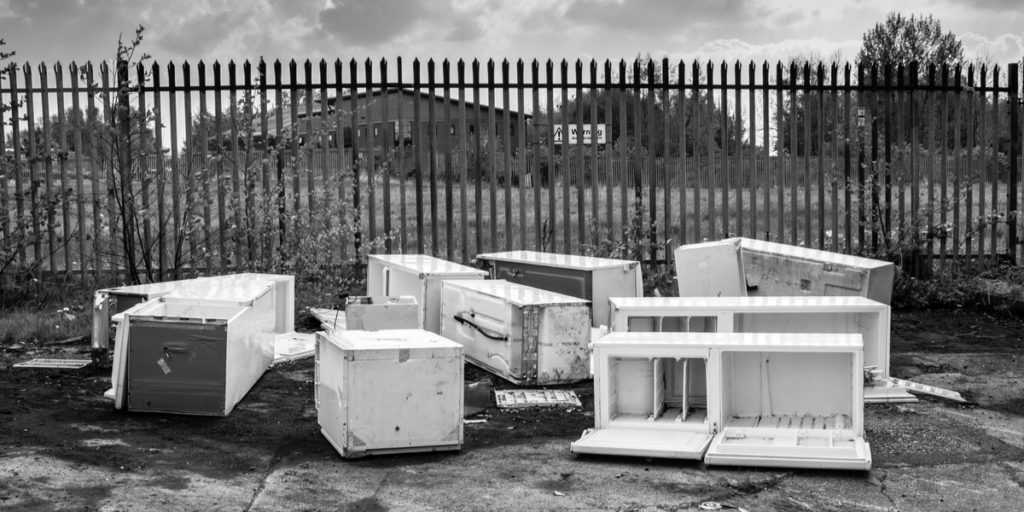The Problem Of Fly Tipping
I do enjoy a bit of road cycling, yes I’ve reached the age of becoming a MAMIL! (a middle aged man in Lycra), in case you have never heard of that one before. I’m quite lucky that the area where I mostly cycle, the North Pennines, is a beautiful place with stunning views and many nice, quiet and largely traffic-free roads. However, one issue that really makes my blood boil when I’m out for a ride is the amount of waste that is illegally disposed on the side of the road. I’ve seen many different types of waste over the years such as TVs, construction materials, tyres, carpets and more.

This type of disposal of waste is known as ‘fly tipping’ in the UK. The definition of fly tipping is the illegal dumping of waste that can vary in quantity, from just a few items up to truck loads. It differs from littering, as it is tipped following removal from the premises that created it with a deliberate aim of disposing it unlawfully, or standard outlets not being available.
Fly tipping is a significant problem in the UK, just take a look at these statistics for the year 2017/18. These stats are from the National Fly Tipping Prevention Group, a UK government body set up to tackle the issue:
- Local authorities in England dealt with nearly 1 million fly tipping incidents,
- The most common place for fly-tipping to occur was on highways,
- Local authorities carried out 494,000 enforcement actions for fly tipping, and
- Most common size category for fly-tipping incidents in 2017/18 was equivalent to a ‘small van load’ (33%) with 4% of all incidents were ‘tipper lorry load’ size or larger.
These statistics show that fly tipping is a major problem and has negative implications such as:
- Costs of investigating and clearing up fly tipped waste is estimated to be between £86 million – £186 million per annum
- It presents a significant threat to humans and the environment
- Legitimate hardworking waste contractors are outcompeted for work by rogue traders

Fly Tipping And The Law
From a business perspective, you have a responsibility for your waste which is enshrined in law, under Part II of the Environmental Protection Act 1990 and associated secondary legislation. In this legislation you have ‘a duty of care’ for waste, no matter the quantity or type. If your waste ends up being fly tipped and you did not take reasonable steps to prevent it, your organisation could be prosecuted.
Such steps would often include using a registered waste business to collect, recycle or recover your waste. Alternatively, you must be properly registered to carry out these actions yourself. You must keep a record of the waste that is taken from your site in a specified format, and keep such records for two years for non-hazardous waste, and three years for hazardous waste. In the UK, The Environment Agency (EA), Scottish Environment Protection Agency (SEPA), Natural Resources Wales and Northern Ireland Environment Agency and the Local Authorities (LAs) are the regulators for fly tipping. Smaller scale incidents are dealt with by LAs, whilst major incidents are dealt with by the EA, SEPA, etc – depending on location.
Discovering Fly Tipped Waste
Unfortunately, if you discover waste on your premises that has been fly tipped then it is your responsibility to remove the waste. You will have to pay the costs associated with removal of this waste. This will be reimbursed if a prosecution is successful. Regardless of this, you should report the incident to the relevant authority. Fly tipped waste can be dangerous so it is not advisable to look for clues as to its origin.
The waste must be removed by a competent, registered waste contractor. Try to remove it as quickly as possible, as fly tippers may be encouraged to tip in areas where they see fly tipped waste already present.
Preventing Fly Tipping
In addition to your legal duties with regards to waste if you need to advise your organisation on how to reduce the risk of fly tipping following an incident, then consider the following:
- Physical structures – in areas prone to fly tipping consider the installation of barriers, fencing or lighting
- Improved site management – remove fly tipped waste quickly and generally keep a site free from litter and waste
- Deter fly tippers – use signage, CCTV or expand or introduce security patrols
- Environmental Management System (EMS) – formally incorporate the issue into your organisations (EMS)
Hopefully this post has given you some useful information on the scourge that is fly tipping; and gives you some ideas on your legal duties, what to do if you discover such waste and how fly tipping can be prevented.
–
John Binns BSc (Hons), MSc, MSc, MIEMA

With over 19 years’ experience working in environment management, John Binns BSc (Hons) MSc MIEMA is an experienced environmental tutor and consultant with knowledge of health and safety management.
